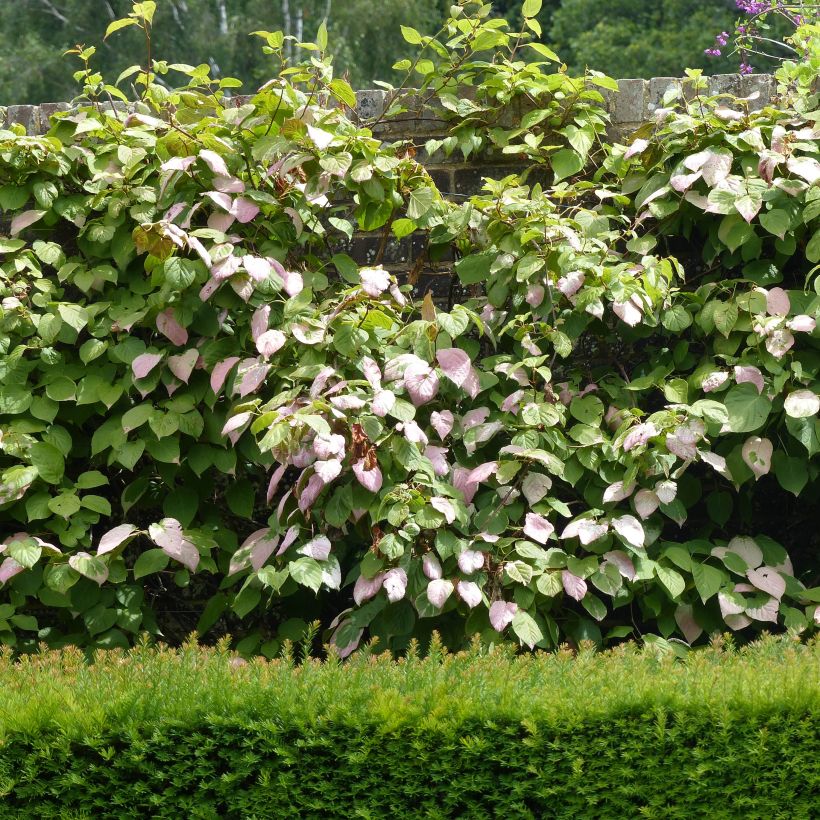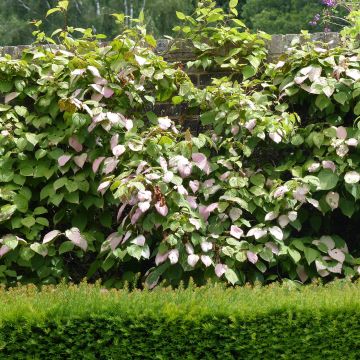

Actinidia kolomikta Eve


Actinidia kolomikta Eve
Actinidia kolomikta Eve
Actinidia kolomikta Eve
Kolomikta
This item cannot be shipped to the selected country
Delivery charge from €5.90
More information
Delivery charge from €5.90
More information
Schedule delivery date,
and select date in basket
This plant carries a 6 months recovery warranty
More information
We guarantee the quality of our plants for a full growing cycle, and will replace at our expense any plant that fails to recover under normal climatic and planting conditions.
From €5.90 for pickup delivery and €6.90 for home delivery
Express home delivery from €8.90.
Does this plant fit my garden?
Set up your Plantfit profile →
Description
The Actinidia kolomikta 'Eve', also known as the kolomikta 'Eve', is a female ornamental kolomikta. Like the species, it has ever-changing foliage, beautifully variegated with pink and cream on a green background in spring. In late spring, its discreet small white flowers perfume the garden. This deciduous bush with climbing stems is also interesting for its moderate growth for a kolomikta , making it more suitable for small gardens. It is not very hardy and prefers to be grown in indirect sun, such as against an east or southeast-facing wall, in a damp, rich, well-drained soil, preferably non-calcareous. This female variety produces edible oblong green fruits. It is pollinated by the 'Adam' cultivar.
Actinidia kolomikta belongs to the Actinidia family. It is native to an area ranging from China to Japan, Korea, and Russia, where it can be found in the Amur River region and on Sakhalin Island, for example. Its natural habitat consists of not too dense coniferous forests, where it can form thickets along riverbanks or in clearings. In the southern part of its range, it grows up to 1300-1400 m (4265-4593ft) altitude on rocky plateaus. In the north, however, this species does not climb above 150 m (492ft) altitude. This plant was introduced into cultivation in 1855. It can withstand brief freezes of around -7/-8°C (19.4/17.6°F).
It is a fast-growing woody plant, with climbing stems that quickly reach 5 to 6 m (16 to 20ft) in length. They need to be guided towards a support on which they will twine. The main asset of this kolomikta is its foliage: when the leaves emerge in spring, they are bronze, then green. Later, around May, before flowering, most of the leaves turn a bright white. After flowering, in June-July, they become pink, then crimson red. In autumn, before falling, they take on different shades of yellow, pink, or purple-violet. Like most Actinidia, this species is dioecious: there are separate male plants from female plants, which will bear fruit only in the presence of a male plant nearby. The 'Eve' cultivar is a female cultivar that requires pollination by Actinidia k. 'Adam' to bear fruit. Flowering occurs around mid-June and lasts for about twenty days. The flowers are small cups, 1.5 cm (1in) in diameter, formed by six white to pink petals, gathered in small clusters. They emit a pleasant fruity fragrance. When the fruits form, they are dark green with darker green stripes, 3 cm (1in) long and 1.5 cm (1in) wide, edible but not very aromatic. They ripen around mid-September.
The Actinidia Kolomikta 'Eve' appeals to gardeners for its spectacular colours, as well as to felines. Your cat - or the neighbour's cat - will come and sniff and nibble with delight on its young shoots in spring... Plant it against a wall that you have covered with a large trellis, on a small garden shed, or even on a fence. It can also be grown in a container, although its growth will be less vigorous. To accompany it, consider a small summer-flowering clematis such as Picotee or Little Mermaid, for example. In partial shade, it will create a lovely scene with shrub hydrangeas.
Actinidia kolomikta Eve in pictures




Plant habit
Flowering
Foliage
Botanical data
Actinidia
kolomikta
Eve
Actinidiaceae
Kolomikta
China
Other Ornamental Kiwi - Actinidia
Planting and care
Actinidia kolomikta is sensitive to severe frosts and can withstand brief freezes of around -7/-8°C: it prefers a sheltered location and a rich, well-drained, neutral or acidic soil (it does not tolerate limestone soils). A soil rich in humus, which is both light, fertile, and moist, is ideal. Mulch the plant in autumn to protect the stump from the cold. In case of harsh winters, prune severely in spring. It is quite demanding and appreciates organic fertilisers in spring. It does not require pruning. However, in autumn, you can shorten the one-year-old shoots by about a third. To promote the emergence of pink and white leaves in spring, plant it in a sunny location, but not scorching sun. The vegetation of this Actinidia can be quite heavy and may require staking after one or two years.
Planting period
Intended location
Care
This item has not been reviewed yet - be the first to leave a review about it.
Haven't found what you were looking for?
Hardiness is the lowest winter temperature a plant can endure without suffering serious damage or even dying. However, hardiness is affected by location (a sheltered area, such as a patio), protection (winter cover) and soil type (hardiness is improved by well-drained soil).

Photo Sharing Terms & Conditions
In order to encourage gardeners to interact and share their experiences, Promesse de fleurs offers various media enabling content to be uploaded onto its Site - in particular via the ‘Photo sharing’ module.
The User agrees to refrain from:
- Posting any content that is illegal, prejudicial, insulting, racist, inciteful to hatred, revisionist, contrary to public decency, that infringes on privacy or on the privacy rights of third parties, in particular the publicity rights of persons and goods, intellectual property rights, or the right to privacy.
- Submitting content on behalf of a third party;
- Impersonate the identity of a third party and/or publish any personal information about a third party;
In general, the User undertakes to refrain from any unethical behaviour.
All Content (in particular text, comments, files, images, photos, videos, creative works, etc.), which may be subject to property or intellectual property rights, image or other private rights, shall remain the property of the User, subject to the limited rights granted by the terms of the licence granted by Promesse de fleurs as stated below. Users are at liberty to publish or not to publish such Content on the Site, notably via the ‘Photo Sharing’ facility, and accept that this Content shall be made public and freely accessible, notably on the Internet.
Users further acknowledge, undertake to have ,and guarantee that they hold all necessary rights and permissions to publish such material on the Site, in particular with regard to the legislation in force pertaining to any privacy, property, intellectual property, image, or contractual rights, or rights of any other nature. By publishing such Content on the Site, Users acknowledge accepting full liability as publishers of the Content within the meaning of the law, and grant Promesse de fleurs, free of charge, an inclusive, worldwide licence for the said Content for the entire duration of its publication, including all reproduction, representation, up/downloading, displaying, performing, transmission, and storage rights.
Users also grant permission for their name to be linked to the Content and accept that this link may not always be made available.
By engaging in posting material, Users consent to their Content becoming automatically accessible on the Internet, in particular on other sites and/or blogs and/or web pages of the Promesse de fleurs site, including in particular social pages and the Promesse de fleurs catalogue.
Users may secure the removal of entrusted content free of charge by issuing a simple request via our contact form.






































